Surprising ways home decor can boost your happiness
Learn simple tricks to help rejuvenate your home, de-clutter your life, and clear your mind.
Updated on November 11, 2022
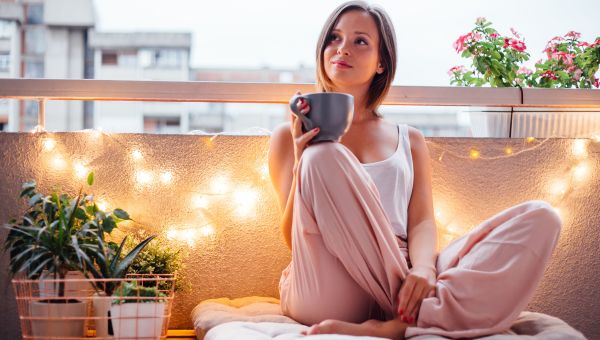
No matter where you live, careful design can turn your space into a sanctuary. Elements like room layout, sounds from the street, and even the color of your throw pillows come together to determine the character of your home. And good design is about more than aesthetics—it influences your mental and physical health in surprising ways.
With that in mind, here are nine simple ways to both make over your home and improve your outlook.
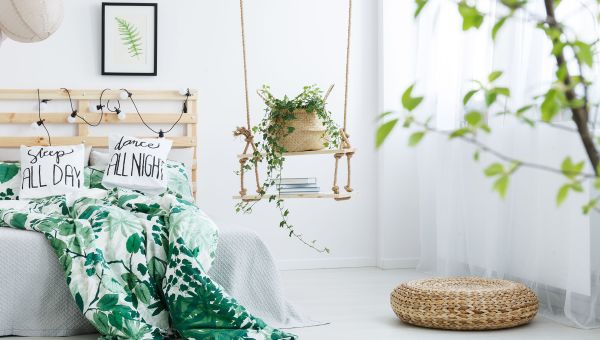
Make nature your muse
Humans aren’t meant to be kept in captivity, yet the average person spends about 90 percent of their time indoors. Research suggests it’s worth making the effort to get in closer touch with nature:
- People in urban areas who live in green spaces are less likely to die of any cause than urban dwellers who don’t live near parks or gardens, according to a 2019 article in The Lancet.
- Walking through a park can reduce blood flow to the part of the brain responsible for rumination (repetitive, negative thoughts), according to a 2015 study completed at Stanford University and published in PNAS.
The flowers, stone, wood, and colors you’d see on a nature trail—which help to clear your mind and calm you—can be brought into your home, says Neesha Berry, MD, an internal medicine doctor in Southfield, Michigan.
- Choose sand or sky (grey, ivory, white) colors for backdrop items like your couch or carpet.
- Include furniture or accent pieces with wood paneling.
- Decorate with items that show nature like floral pillows or high-resolution photos.
- Bring in real, responsibly sourced items from the outdoors, like finished driftwood.
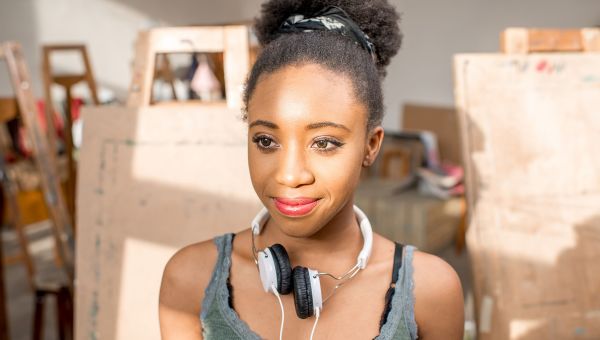
Let the light shine in
If possible, make the sun your primary source of light during the day. This may help:
- Lower your electric bills.
- Improve your sleep: Sunlight sends visual cues to your brain to help control your circadian rhythm.
- Feel better: Hospital patients residing near the window had shorter lengths of stay than those by the door, according to a 2018 study published in Environmental Health Insights.
- Boost productivity: Daylight promotes alertness.
“Don’t position furniture so it blocks windows,” says Dr. Berry. “You should be able to open windows to let in natural air and light. You want to see the flowers, trees, birds, and people walking past.”
If glare becomes an issue, or if sunlight spikes your air conditioning usage, invest in transparent window films, which can reduce glare and improve temperature control.
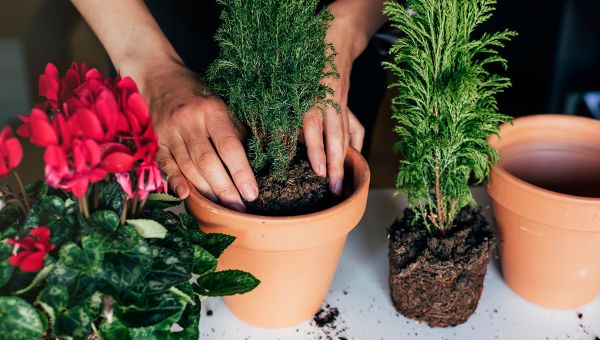
Get your hands dirty
Blur the lines separating your home from Mother Nature by surrounding yourself with vibrant, easy-to-care-for plants. Here’s how to incorporate greens into your design:
- Grow fresh herbs and spices in your kitchen. Place them along the windowsill or hang them in decorative containers on the wall. Mint and basil are especially easy to care for and smell great.
- Keep small plants like succulents or cacti on your desk. Just make sure the pots don’t leak and don’t overwater your plants, which may promote mold growth.
- Place a tall plant, like a fiddle-leaf fig tree, in a corner of your living room. (This tree grows to around 5 to 7 feet and has large, fiddle-shaped leaves.)
- Include stylish hanging plants like philodendron, which thrives year-round and only needs to be watered when the top layer of soil dries out.
Keep a container garden inside or a full garden in your yard, recommends Berry. Whether it's just a few herbs or a larger bounty, you’ll benefit emotionally from caring for the plants, and physically from eating your own fresh produce.
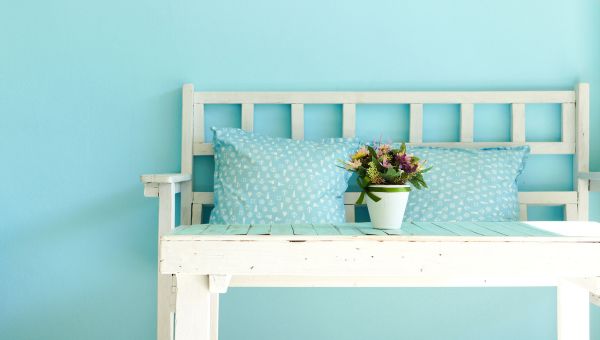
Smooth on a fresh coat of paint
A long history of psychology research suggests certain colors have calming effects, while others promote the flight-or-fight response. Picking out paint swatches? Consider these findings:
- Blue has been found to reduce blood pressure and increase blood flow. It may also make you feel calmer and more relaxed.
- Yellow may promote creativity and energy.
- Green may also encourage creativity.
- Red is often linked to stress or excitement and may interfere with critical thinking—it’s the color of sports cars and racy underwear for a reason.
“Certain colors help you relax and unwind,” says Berry. “Blue may remind you of the ocean. Cream invokes sand on the beach, and pale gray is almost universally calming.”
Note: While the above colors are traditionally thought to produce these effects, culture and personal experience ultimately determine the emotions people associate with colors. The saturation and intensity can also change how visually straining or distracting a color appears, influencing your reaction to it.

Select feel-good fabrics
Rugs, blankets, and curtains occupy large amounts of visual space. Use those blank canvases to add splashes of color, create a calming backdrop, or to display interesting patterns. But don’t forget about the touch and feel of fabrics—consider all your senses to truly make your home a comfort zone.
Things to consider when choosing fabric:
- For blankets: Cotton is ideal because it’s warm, but breathable, so you won’t wake up from overheating.
- For throw pillows: If you have allergies, avoid down-stuffed pillows since they can trigger symptoms. Choose polyester or synthetic down instead.
- For rugs: Nylon is a synthetic fabric that comes in many textures and colors. Depending on the style and brand, it can offer the feel of a high-end fabric, without the cost. It’s also stain-resistant and tends to keep its original texture.
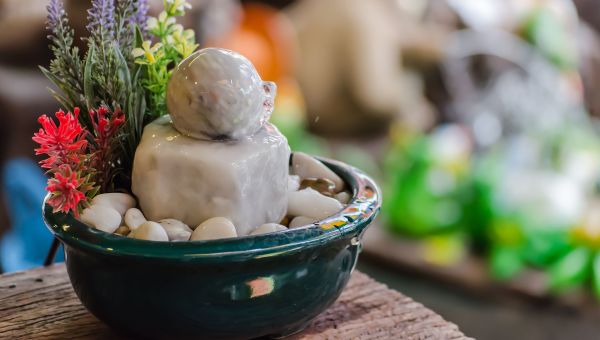
Drift away to soothing sounds
Noise pollution isn’t just a nuisance, it can trigger stress, interrupt sleep, and may increase heart disease risk. While it’s not a problem for everyone, city dwellers and people living near highways or airports should consider ways to mitigate noise pollution in their home design.
Invest in a noise-eliminating or white-noise device. Place it by your door to block out street sounds. Then, fill your home with better acoustics:
- Zone out to wave or rain sounds. For example, Sharecare’s relaxation content on YouTube is ideal for drifting off to sleep.
- Place a fan with different speed settings in your bedroom for white noise while you sleep.
- Play soft, crackling fireplace sounds in the background while working or relaxing.
- Keep a small, decorative fountain in your bedroom, recommends Berry. The sound of flowing water can be calming.

Inhale lavender (exhale tension)
Aromatherapy is the practice of inhaling scents to bring about a desired health effect. While many studies have looked at the potential benefits of aromatherapy, results have been mixed. Also, some experts wonder whether its benefits arise from the hope or expectation that it will work.
While more research is needed, some findings suggest that certain scents might help ease anxiety and depression symptoms.
- Orange
- Lavender
- Rose
- Bergamot
- Lemon
- Sandalwood
Lavender is especially well known for encouraging sleep and relaxation. And pleasant-smelling things like fresh flowers, essential oils, and candles are simply enjoyable additions to the home. Pregnant and breastfeeding women should check with a healthcare provider before using essential oils.
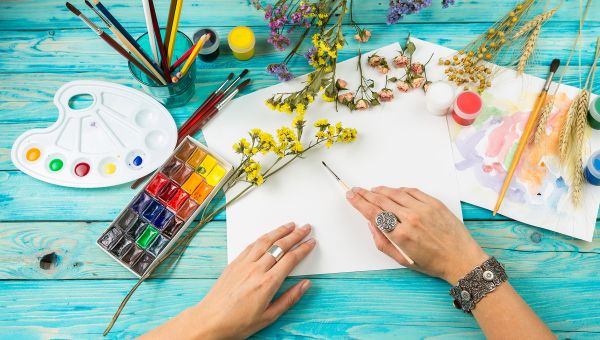
Let accent pieces prompt healthy habits
Keep a colored pencil set or watercolors on your nightstand, along with a favorite coloring book. They’ll make for eye-popping additions to your bedroom décor, but they can serve an even greater purpose—they’ll be readily available as a soothing distraction when you lie awake worrying at night. A few minutes of coloring may relax you enough to fall asleep.
Apply this principle to other health goals. Want to build exercise into your routine? Display colorful dumbbells near your TV for exercise breaks during commercials. Trying to read more? Make your bookshelf an eye-catching centerpiece, complete with keepsakes, photos, decorative bookends, and a selection of handsome books.
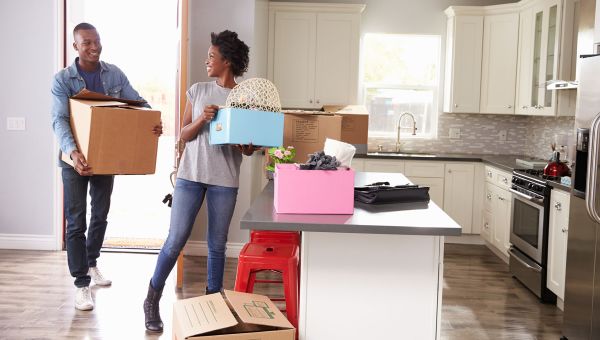
Banish clutter
“For overall peace of mind, keep your home as clutter-free as possible,” recommends Berry. “The fewer unnecessary items you have, the better. Decluttering cuts down on dust, tripping hazards, and reduces the time you need to spend cleaning. Being in a decluttered atmosphere just helps you feel clearer mentally.”
Some tips to get you started:
- Electronically scan personal records like old receipts and tax returns. Once they’re stored on your computer—and backed up to the cloud or an external hard drive—safely discard papers by shredding them.
- Clean out your closet and donate old clothes to a charity like Dress for Success, which helps women achieve job security and independence by providing support and professional attire.
- Don’t leave shoes in a heap at the bottom of your closet. Fix shoe chaos with a shoe rack, over-the-door organizer, or under-the-bed drawer.

United States Environmental Protection Agency. Indoor Air Quality. Updated September 7, 2021.
Rojas-Rueda D, Nieuwenhuijsen M, et al. Green spaces and mortality: a systematic review and meta-analysis of cohort studies. The Lancet. 2019; 3:469-477.
Bratman G, Hamilton P, et al. Nature experience reduces rumination and subgenual prefrontal cortex activation. PNAS. 2015; 112: 8567-8572.
Park MY, Chai CG, et al. The Effects of Natural Daylight on Length of Hospital Stay. Environmental Health Insights.2018; 12.
Stern M, Broja M, et al. Blue light exposure decreases systolic blood pressure, arterial stiffness, and improves endothelial function in humans. European Journal of Preventive Cardiology. 2018; 25: 1875–1883. 2016; 41:195-205.
AL-Ayash A, Kane R, et al. The influence of color on student emotion, heart rate, and performance in learning environments. Color Research and Application.
Tofle RB, Schwarz B, et al. Color In Healthcare Environments – A Research Report. Coalition for Health Environments Research. July 2004.
United States Environmental Protection Agency. Clean Air Act Title IV - Noise Pollution. Updated August 11, 2022.
National Cancer Institute. Aromatherapy With Essential Oils (PDQ®)–Patient Version. Updated August 16, 2022.
NIH: National Center for Complementary and Integrative Healthy. Aromatherapy. Last updated January 2020.
Main Line Health. What essential oil is best for anxiety? January 23, 2020.
Sánchez-Vidaña DI, Ngai SP, et al. The Effectiveness of Aromatherapy for Depressive Symptoms: A Systematic Review. Evid Based Complement Alternat Med. 2017;2017:5869315.
Johns Hopkins Medicine. Aromatherapy: Do Essential Oils Really Work? Accessed November 11, 2022.
Barati F, Nasiri A, et al. The Effect of Aromatherapy on Anxiety in Patients. Nephrourol Mon. 2016 Jul 31;8(5):e38347.
Mayo Clinic. Home Remedies: What are the benefits of aromatherapy? May 8, 2019.
Cancer Research UK. Aromatherapy. Last reviewed May 31 2022.
Cleveland Clinic. 3 Reasons Adult Coloring Can Actually Relax Your Brain. May 27, 2020.
Mayo Clinic Health System. Coloring is good for your health. August 15, 2022.
Utah State University Mental Health Extension. The Mental Benefits of Decluttering. July 1, 2022.
Mayo Clinic. How decluttering your space could make you healthier and happier. May 20, 2021.
More On


video

article

slideshow


video


video
